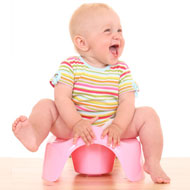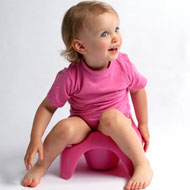Visible Stages in Baby Potty Training
The physiological signs that show your child’s readiness for potty training are his or her ability to let you know that they need to use the pot, most commonly expressed by grunting sounds or squatting. Facial expressions also show that a child feels uncomfortable and needs to relieve himself. Keeping control over the bladder and bowel are other signs that express readiness.
If a child has a dry diaper throughout the day, it shows that there is control over the bladder and bowel. Motor skill readiness involves your child’s ability to undress him or her self when the need to use the potty arises.
Nighttime potty training for babies
Another important aspect of potty training is night time potty training for babies. Though night time potty training may sound as easy as regular potty training, it requires a completely different set of skills from both, parent and child. The first thing to keep in mind while training your child to use the potty at night is that he or she should be able to wake from a deep sleep and use the pot. This can be facilitated by the practice of waking up your child gently in the middle of the night and asking whether there is a need to use the toilet. While training them to use the potty at night, it is best that you let children do things for themselves, after having woken them up.
Supervise their actions, but don’t involve yourself because doing so will deprive them of learning to do things on their own.
Other signs for baby potty training
Apart from being able to stay dry from control over the bladder and bowels, other baby potty training signs include children asking you if they can use the bathroom with words that are connected to the activity itself. Signs such as holding the genital area and doing a dance often indicate urgency to use the wash room. As babies grow older, it becomes easier for them to express themselves. Similarly, for a parent, observance of these small signs will suffice as an indication that your child is uncomfortable and is in need of the pot. As soon as both, parent and child are prepared, the potty training process will prove extremely beneficial.


